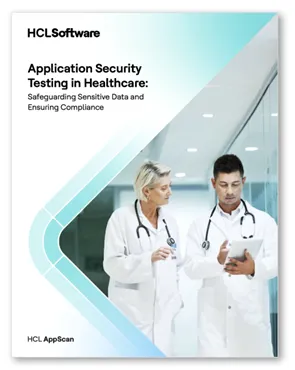As healthcare continues its digital revolution, the systems that power patient care are becoming as vital as the care itself. From EHRs to telehealth platforms, healthcare applications are now essential infrastructure—but they also represent one of the sector’s greatest security risks.
A new whitepaper from HCL AppScan examines this growing tension between innovation and risk, outlining how Application Security Testing (AST) is now a key part of keeping patient information safe and ensuring compliance with ever-tightening regulations.
Digital Transformation and Rising Risk
Healthcare’s adoption of technology has brought many benefits such as improved efficiency, accessibility, and outcomes. However, it has also made the industry a prime target for cybercriminals. The data housed within healthcare systems—PII, medical histories, financial records—is among the most sensitive and lucrative to attackers.
The whitepaper highlights that ransomware attacks targeting healthcare have surged by 55%, with average data breach costs reaching $10.93 million per incident. These aren’t just financial losses; they represent serious disruptions to patient care and long-term trust.

Common Vulnerabilities in Healthcare Applications
Healthcare applications are particularly susceptible to a range of security flaws. The whitepaper details several high-impact vulnerabilities, including:
- Ransomware: Attackers encrypt records and demand payment, often halting services.
- Injection Flaws: Issues like SQL injection and cross-site scripting allow attackers to manipulate or access systems through insecure code.
- Authentication and Authorization Weaknesses: Inadequate access controls can lead to unauthorized data exposure.
- Data Misconfigurations: Mismanaged cloud services or APIs leave sensitive data exposed.
- Outdated Software: Unpatched systems create exploitable entry points for malware and unauthorized users.
The Role of AST in Securing Healthcare Applications
AST is a proactive strategy for identifying and addressing these vulnerabilities before they can be exploited. The whitepaper explores how different methodologies—each suited to different stages of the software development lifecycle—contribute to a more secure environment:
- SAST (Static Application Security Testing) scans source code early in development to catch flaws before deployment.
- DAST (Dynamic Application Security Testing) tests running applications to simulate real-world attacks.
- IAST (Interactive Application Security Testing) provides feedback during runtime, blending insights from SAST and DAST.
- SCA (Software Composition Analysis) helps identify risks in open-source or third-party components—a growing concern in healthcare development.
Combining, these approaches enable healthcare organizations to build secure software from the ground up and maintain protection throughout the SDLC.
Compliance and Continuity
Security in healthcare goes beyond stopping cyberattacks; it’s also involves adhering to strict regulatory requirements. Regulations like HIPAA, GDPR, and HITRUST set high standards to keep healthcare data safe. Strong AST helps organizations meet these rules while also making sure healthcare services run smoothly without interruptions.
According to the whitepaper, healthcare organizations that adopt comprehensive application security testing not only reduce the likelihood of incidents by as much as 47%, but also strengthens patient’s trust and prevents costly disruptions to critical services.
For healthcare leaders, security can no longer be an afterthought. This whitepaper offers a clear, detailed view of today’s vulnerability landscape, and a roadmap for how HCL AppScan, an application security testing software can help close the gaps before they’re exploited.
Download the full whitepaper to learn how proactive security testing can protect your patients, your data, and your reputation.
Start a Conversation with Us
We’re here to help you find the right solutions and support you in achieving your business goals.







